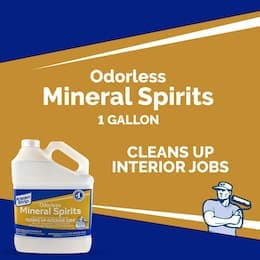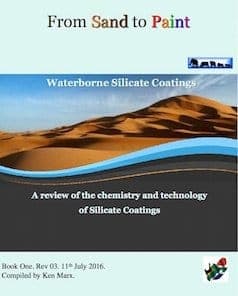
-----
What is really inorganic paint?
Q. What is an inorganic paint - silicate paint and silica based paint? They all claim themselves as inorganic but companies modify the binder with acrylic which is organic material. Then, how we define inorganic and organic? They are so confusing and we should use what criteria to differentiate and find out the guideline in this aspect.
Paul Wong- Hong Kong
2002
A. Paul,
I fail to see/understand/comprehend WHY you are even bothered to ask the question. Who cares?
Anyhow, I don't think you can call acrylic an 'organic' but if you did so, then epoxy, vinyl, urethane etc etc would all fall into that bracket. Acrylic is methyl methacrylate ... well it is until you harden it or catalyze it in order to become useful gets called polymerized.

Freeman Newton [deceased]
(It is our sad duty to advise that Freeman passed away
April 21, 2012. R.I.P. old friend).
2002
A. Hi,
First, I'm not an expert in paints and won't answer Mr.Wong, but it wouldn't hurt me to know more about the subject. This is a forum to spread knowledge and help each other. Now, if Paul's question seemed irrelevant to Mr. Freeman, why did he bother answering. And if he did, he should have showed more respect and illustrate himself just a little bit on the subject. Plastics seem to be Mr. Freeman's favorite theme, so it's incredible that he knows their formulation but doesn't recognize them as organic (Vinyls, Acrylics, Propylenes, Amides, Ethylenes, Styrenes, Urethanes, etc. must be called organic because that's just what they are). They burn and leave carbon. Not so the silicates.
Guillermo MarrufoMonterrey, NL, Mexico
2002
A. Paul,
Seeing that I have been 'hauled over the coals' by Guillermo, then I apologize most sincerely but ignorance is bliss and it was in a blissful state of mind that I felt that plastics aren't necessarily organics. I seem to have erred, a common complaint says my wife.
Mind you, even with a silica based paint, you are going to have a carrier/binder of some sort in order for it to 'flow' and to 'adhere'... probably carbonaceous, too! eh?
Thank you Guillermo! Mind you, iron is partially organic, too. It contains carbon ... (I seem to recall that cast iron had to be under 0.5 percent) I guess that most things contain carbon, even homo sapiens.

Freeman Newton [deceased]
(It is our sad duty to advise that Freeman passed away
April 21, 2012. R.I.P. old friend).
2002
A. Recalling my chemistry background decades ago, a material is organic only if it is formed by carbon chains with hydrogen as a main binding atom at the end of dangling bonds. For example CH4 is a basic element of such chains. Most organics are C-H chains with additions of other elements at some sites. So, Homo Sapiens are organic but pure carbon, graphite and steel are not. Correct me folks if I am wrong !
Mandar Sunthankar- Fort Collins, Colorado
2002
|
A. Right and thank you for the precision, Mandar! Indeed, iron is a generic but incorrect word to name cast or wrought alloys of iron (Fe) with various levels of carbon (it even designates the usual aluminum made home appliance with perhaps zero iron or carbon). Cast iron usually has from 3 to 5%C and low carbon commercial steels usually below 0.1%C , but there are many more substances that do contain carbon and are not organic since carbon is not present in the way described. Two examples: CO and CO2. Regards, Guillermo MarrufoMonterrey, NL, Mexico 2002 A. Additions to my comments above: I think there may be some confusion here about organics vs. polymers. Organics have to have carbon chains but not necessarily for polymers. Polymers can be other chains, e.g. that of silicon. Recently, Inorganic Polymers is becoming a hot topic in the chemical industry. Mandar Sunthankar- Fort Collins, Colorado 2002 |
Q. Dear Guillermo!
Re your statement that cast iron has always a carbon content of 3% to 6%, is that really true?
Cast iron is known to be pretty brittle ... but WAY back in history, around 1895 at the then Paris Exhibition, a bell was shown made of malleable cast iron where the carbon content was, I was led to believe, around 0.5%. This was real NEWS then.
This bell (incidentally it's about 9 feet in diameter!) is now on display near the Ratshaus (town hall) of the town of Bochum, West Germany. It was made by the Bochumer Verein Company(during WW2 they had over 20,000 workers) and when Friederich Krupps, the head of the Krupps Steel Works, heard of this he was mad as hell ... as the B.V. had stolen a technological march on him.

Freeman Newton [deceased]
(It is our sad duty to advise that Freeman passed away
April 21, 2012. R.I.P. old friend).
2002
A. Hello, Freeman,
Thank you for your historical reference, but I never said cast iron must have 3-6% carbon. I said it "usually" has between 3 and 5 and I stand to my comment. After review of some specifications on malleable iron (similar to nodular in carbon content though in a different manner) I verified that, indeed, these types range in content of around 2.2-2.9%. I understand that the difference between steel and cast iron is the presence of free (undissolved) carbon in the later. According to the phase diagram for iron-carbon a content of 0.5% carbon will always dissolve in the iron soup (liquids) at the melt temperature and will never precipitate at solids thus giving a steel. Definitely, if your passage is accurate about that 0.5% carbon, then the bell was actually steel not cast iron.
Best regards,
Guillermo MarrufoMonterrey, NL, Mexico
2002
Q. Our learned friends. Thank you for a debate on Organic and Inorganic. Certainly very enlightening. However poor Mr. Wong's question seems to be unanswered. Can we help him? Someone please! I too would like to know whether the classification is based on the Binder or the pigment.
Choon Far Chen- Brunei
2002
A. Well, yes it is called silicate paint but the international standard for silicate paint is less than 5% of organic compound. Just as cast iron still has iron in it. Or the difference between cyan and blue. A cup of coffee is still a cup of coffee, unless the sugar content is too high. It is still a cup of coffee. It is sad to see people debate so much on this issue which we see in our everyday life.
Fong Tan- Singapore
2003
A. Will try to be brief. Organic (carbon based) paints are produced from polymers (urethane, acrylic, PVC, or many many other polymers) which are "carried' by either water or solvents (boiled linseed oil
⇦ on
eBay
or
Amazon [affil link]
, mineral spirits, etc). Organic paints when fully cured or polymerized are very chemically resistant but yield high levels of VOC's volatile organic compounds as they are drying or when they are burned.
Mineral paints are produced from inorganic materials (non carbon based or natural minerals such as clay, silica, calcium, etc). They are carried by water or high concentrations of silicates - sodium or potassium - in a water solution. Silicate paints when fully cured are very chemically resistant but only water vapor is given off as they cure.
The concept of organic content in silicate paints is a bit more complex. Mineral paints such as white wash (calcium carbonate in water)have no organic compounds. Silicate paints may or may not contain organic compounds and if there organic additives in the silicate paint they most likely will not be released as a VOC during curing or during combustion.
Silicate paints have been used in Germany for more than 125 years to coat masonry surfaces and contained no organic materials. In the last decade it has been learned that silicate paints can be blended with organic polymers to create very unique and high performing coatings that have minimum or no VOC's or other liabilities associated with organic paints.
- Tallahassee, Florida
2006
Q. Anyone could give me some information on geopolymer inorganic paints?
Lili TY- Munich Germany
2006
A. Inorganic coating are as you said composed of silicon or silicate when these materials are mixed with an organic binder to promote film properties they are known as hybrid coatings.
Hybrid coatings are of four types
1. where like in as you have mentioned organic material in an inorganic matrix e.g., small amount of acrylic emulsion with silicate paints
2. then there is inorganic material in an organic matrix e.g., pigments in any organic polymer
3. IPNS where the organic and the inorganic part react separately and form films
4. where the organic and inorganic and organic parts are chemically bonded (pure hybrids)
- Pune, Maharashtra, India
2006
A. This is in response to Mr. Wong's original question :
Inorganic ( Silicate ) Mineral Paint is in principle inorganic, because the binder is an inorganic water-soluble potassium silicate. In order to cure, this binder chemically reacts in most cases with the mineral-based substrate or CO2 from the air. It is not film-forming, but makes a micro-crystalline ( vapour-permeable ) coating. These 2 attributes are the main difference to acrylic-based, film-forming coatings, which eventually blister and peel due to aging or caused by moisture trapped under the paint.
The addition of max. 5% acrylics acts as a temporary stabilizer, which keeps the coating from being washed off during the initial curing period, which can take several weeks. On the other hand, 5 % acrylics do not interrupt the vapour- permeability to any measurable extend.
There is no international standard for inorganic mineral paint. There are only a few European national standards.
Our company follows German standards.
- Fredericton, New Brunswick Canada
July 28, 2008
A. Hi all, here is a tutorial page about silicates in general, and different silicates binders particularly.
www.asdn.net/asdn/chemistry/silicates.shtml
I hope it may be useful!
NT-MDT - Mesa, Arizona, USA
June 20, 2011
A. In the coatings world, organic = binders/resins made from once living things. Inorganic is not. So any resins or binders derived from petroleum are considered organic. Acrylic acid is derived from propene which is a byproduct of gasoline production thus the substance is organic. I'm no chemist, but it's just a basic formula in the coatings world.
Steve Zytkowicz- West Chester, Pennsylvania
January 5, 2012
Q. Hello Everyone,
Does anyone have any recommendations for a handbook on inorganic coatings, especially the formulation of inorganic coating for paints?
Thank you.
- Singapore
April 29, 2012
July 9. 2016
A. The attached may not be a simple answer to the question but will allow the reader to understand the basics of "waterborne silicate coatings". It excludes ethyl silicates and focuses on Silicate Paints which Ree is looking for. I hope to have book 2 ready later this year and will cover formulating in a "Students Monograph". This is the only book of this type at the moment from what I can find and what prompted me to write it. It has been reviewed by several people and received good reports but that does not mean you will be able to go ahead and simply make a Silicate Paint.
PS. You may find it easier to print the book which could help in referring back as you need to.
Kind regards,
Ken
Private consultant - Amanzimtoti, Natal, South Africa
e-mail:
Formulation for silicate paint
Q. Dear Sir,
I want to make anticorrosive coating for mild steel from acrylic and styrene emulsion with water soluble method. I want to know which organo silane is suitable for this?
petroils industries - Ankleshwar Gujrat India
March 30, 2017
Q, A, or Comment on THIS thread -or- Start a NEW Thread

